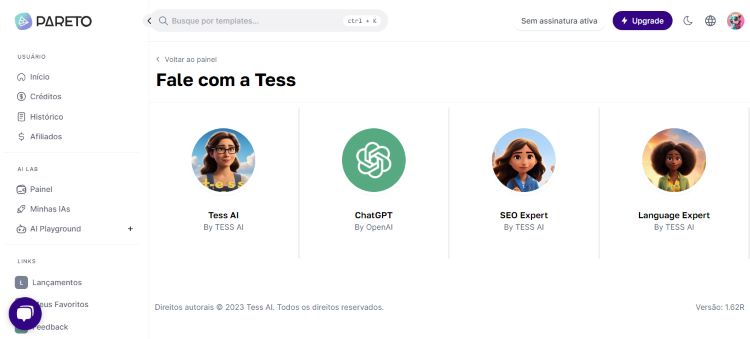Mastering prompt engineering is the key to exploiting the full potential of virtual assistants, chatbots and Artificial Intelligence (AI) models.
Imagine having the power to direct these machines to perform repetitive tasks or even to deliver answers to complex problems. That's where prompt engineering comes in.
This technique allows you to give precise instructions to the AI to get the best results. By mastering it, you'll save time and essential resources for your projects.
What is Prompt Engineering
Prompt Engineering is the process that involves directing solutions from Generative AI solutions to produce the desired results.
Although generative AI seeks to replicate human behavior, it is necessary to provide thorough instructions in order to guarantee relevant, high-quality results.
In prompt engineering, the choice of appropriate formats, phrases, words and symbols is essential to guide AI in the most meaningful interaction with people.
Prompt engineers use creativity and experimentation to develop a series of text entries in order to guarantee the desired functioning of generative AI in an application.
In short, prompt engineering is a term that refers to the process of creating and adjusting prompts (or commands) that are inserted into a language model based on Artificial Intelligence, such as GPT Chat, Midjourney, among others.
Main Examples of Prompt Engineering Applications
There are many ways to apply prompt engineering in your daily life. Here are some examples we've put together for you:
Chatbots and Virtual Assistants

Simplify the automation of answers to frequently asked questions on customer support sites or create chatbots to provide instant assistance.
On the platform Tess AIplatform, for example, you can access virtual assistants to solve questions, even for different applications, such as SEO specialists. With prompt engineering, you can train a chatbot from scratch to facilitate employee access in corporate environments.
Content Generation
With this automation, it is possible to produce articles, essays, summaries, briefings automatically, based on topics, keywords or questions provided. This feature is well used by the community.
Through Tess AIyou can use ready-made templates for content production, or even create your own template, respecting the parameters of your own prompt.
Sentiment Analysis
Evaluate sentiment towards products, brands or topics, based on social media posts and online comments.
All this can be done on the basis of analyzing data from a spreadsheet, in Tess AI you can also insert a Google Sheets spreadsheet containing the comments on a publication, or even a set of recent emails, and ask the AI to identify possible bad or hostile comments.
Language Translation

Facilitate the translation of text, audio and video between languages with ease and precision, thanks to prompt engineering.
With advanced connections to other artificial intelligences, it is possible to translate audio and video files and perform searches on foreign websites, all optimized by artificial intelligence models that are enhanced by prompt engineering.
Answering Questions
Today, the ability to develop applications that readily answer a wide variety of questions is an impressive reality. This is also an achievement that can be exemplified by the Tess AI platform, Pareto's Generative AI.
Through its "Ask about any recent topic" template, Tess AI stands out by searching for answers in real time on the internet, allowing users to get the most relevant and accurate answer to their questions.
This not only speeds up the process of obtaining information, but also illustrates how technology is transforming the way we interact with the digital world, providing quick and relevant answers to our most recent queries.
Different applications
We've covered some of the most common examples when it comes to prompt engineering, but that doesn't stop you from creating your own applications.
You can create concise summaries of books, articles or long documents, saving you time searching for essential information.
You can generate code in different programming languages such as SQL or Python to perform specific tasks or solve problems.
Forecast market trends, stock prices, weather data or other events based on historical data. Improve recommendations for users of streaming platforms, e-commerce, social networks and much more. Access Tess AI and create your own AI model!
Why is Prompt Engineering Important?
Prompt Engineering is crucial because it helps optimize the interaction between users and language models. Prompt Engineers refine responses by identifying customizable scripts and templates to create a library of prompts.
This allows application developers to improve the accuracy of responses. In short, prompt engineering makes AI applications more effective by personalizing user queries.
In short, it's prompt engineering that makes AI applications more effective, but the benefits go beyond that. Check out other examples below to enhance your understanding!
Greater Control for the Developer
Prompt engineering gives developers greater control over the interactions between users and AI.
Effective Prompts provide clarity of intent and describe a solid context for the language models. In doing so, they guide the AI to improve its responses and act as a protective barrier, preventing abuse or requests that are beyond the AI's capabilities.
Improved Quality of Response
Prompt engineering makes it easier to get answers that are aligned with the user's needs, so that they are precise and relevant.
In this way, it allows users to obtain relevant results from the very first interaction, eliminating the process of trial and error.
Flexibility and savings in time and resources
Engineers can create prompts with domain-neutral instructions, highlighting logical connections and broad patterns.
These prompts can be readily reused throughout the company, expanding the potential for investment in AI and saving time in a standardized way.
Better User Experience
Prompt Engineering is an ally in overcoming imperfections in the interaction between the user and the language model training data.
This improved interaction ensures that the AI understands your intent, even with minimal input.
For example, requests to summarize contracts and news will result in customized outputs, suited to the style and need of the document, even if users write: "Summarize this document".

Advanced Prompt Engineering Techniques
Prompt Engineering is constantly evolving, but there are techniques you can use and delve into to refine the tasks of natural language processing of AI models.
Prompting with Chain of Thought
It's a process that breaks down complex questions into smaller steps, mimicking a logical sequence of thought. This allows the model to approach problems in a series of intermediate steps rather than providing a direct answer.
The results can present several answers, and the most common conclusion is selected. If there are significant divergences between the results, human intervention may be required to adjust the logic.
Thought Tree Prompting (ToT)
This technique generalizes and expands prompting with chain of thought, asking the model to generate possible subsequent steps for a question. The model is then executed using a thought tree search.
For example, if the question is about the effects of climate change, the model will generate steps such as "List the environmental effects" and "List the social effects", detailing each in subsequent steps.
Maieutic Prompting
Similar to thought tree prompting, this technique requires the model to respond with an explanation, and then explain parts of the explanation.
Inconsistent explanations are pruned, resulting in improved common sense reasoning.
For example, for the question "Why is the sky blue?" the model could begin with an explanation such as "The sky appears blue to the human eye because the short waves of blue light disperse..." and then expand on parts of it for a deeper understanding, explaining, for example, why blue light scatters more and the like.
Complexity-Based Prompting
The technique involves returning several results of the thought chain. The results with the longest and most detailed answers are chosen, and the most common conclusion among them is selected.
For example, in complex mathematical problems, the results may include several stages of calculations, and the choice is based on the longest chain of thought and common conclusions. For the possibility of being a better explanation.
Prompting of Generated Knowledge
In this approach, the model generates relevant facts before responding to the request. This leads to high-quality results because the model is conditioned by relevant facts.
For example, to write an essay on deforestation, the model first generates how deforestation contributes to climate change, the loss of biodiversity and only then develops the essay based on these facts.
Smallest to Largest Type Prompts
In this technique, the model lists the sub-problems of a question and solves them sequentially. This ensures that later sub-problems can be solved based on the history of previous ones.
So, if a user asks the model for a math problem such as "Solve x in the equation 5x + 2 = 47". The model can list sub-problems such as "Subtract 2 from both sides" and "Divide by 5". It can then solve them in sequence to get the final answer.
Automatic Adjustment Prompts
This technique requires the model to solve the problem, critique the solution and then solve it again, considering the problem, the solution and the critique. The process is repeated until a stopping criterion is reached.
For example, when writing an essay, the model can write, critique, and revise repeatedly until it meets predefined quality criteria or stopping criteria, such as token limits, data and the like.
Directional Stimulus Prompt
This technique includes tips or suggestions, such as desired keywords, to guide the model in achieving the desired result.
For example, when asking for a poem about love, the prompt engineer can include suggestions such as "heart", "passion" and "eternal" to guide the model in creating the desired poem.
10 Expert Tips for Creating Effective Prompts

Prompt Engineering involves a world of possibilities, and in this chapter we'll cover relevant tips that can be applied to both text generation and image creation with AI.
1. Be Specific: When creating prompts, be clear and specific about what you want. For example, instead of asking for a post on productivity, ask for an informative post with five productivity tips for remote working.
2. Formulate Questions and Provide Context: Avoid open-ended questions and provide context. Instead of asking about the benefits of a product, ask them to list the top five benefits for that product.
3. Bring Examples to the Prompt: Offering examples is an effective way of guiding the AI model. For example, if you're looking for a slogan, mention famous slogans, such as Nike's ("Just Do It").
4. Set a Limitation: Limit your answers, such as a maximum number of words. This helps you get concise and useful information.
5. Divide into stages: Divide requests into stages. When creating a marketing offer, for example, start by asking for a definition of the target audience, desires and problems before creating the offer. This improves understanding of the outcome.
6. Ask for Multiple Alternatives: Ask for several alternatives to explore different approaches. For example, "suggest five alternative headlines for intermittent fasting".
7. Diversify the Prompt Length: Test short and long prompts to find the right balance between context and comprehensiveness in the answers.
8. Do Iterative Prompt Engineering: consists of asking questions or giving additional instructions based on the initial responses of the AI chat. This allows for continuous refinement, but only works on an AI connected to a chat system, such as GPT Chat and the Tess AI virtual assistant.
9. Proofread and edit: Always revise and edit your answers to suit your brand and message. Use the answers only as a starting point and use all your creativity to complement them.
10. Test and Improve: Continuously test and improve your prompts. Be agile in your search for improvements and take advantage of all the flexibility that AI can give you. Start developing your AI models today with Tess AI.
How to Become a Prompt Engineer?
There are no prerequisites for becoming a Prompt Engineer, but to specialize in this new profession, you need to have varied knowledge in areas such as linguistics, programming, mathematics and statistics.
You'll have to create and test various commands on generative AIso it will be essential to develop characteristics such as creativity, logical reasoning, critical thinking, communication skills and patience.
Currently, in Brazil, there are no university courses or specializations focused on prompt engineering, but there are free courses on prompt on platforms such as Udemy.
In addition, it is interesting to specialize more and more in AIs, given the continuous growth in recent years. And it's only a matter of time before these study programs emerge or become part of the higher education curriculum.
Prompt engineering is a "profession of the future" with applications in the present, promising progress for both self-employed professionals and companies.
Conclusion
Throughout this article, we have explored the applications of prompt engineering, highlighting its relevance in the age of AI. It is clear that these techniques are fundamental to achieving the desired results and creating innovative solutions to real-world challenges.
The ability to communicate effectively with AIs and extract their full potential is a valuable differentiator in the job market. Not only does it open doors to better content creation, virtual assistants and data analysis, but it also enhances the ability to solve complex problems.
And the best way to learn this trade is to try it out. Remember, practice and experimentation are essential to mastering the technique. Try the Tess AI Platform for free to explore and hone your skills and achieve the best performance!



